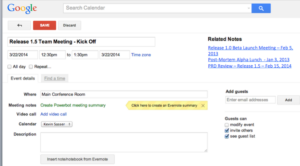If you have been to or heard of ProductCamp – it’s all learning from a vibrant community of peers. With that spirit we are beginning a series of posts featuring different product management professionals from the Atlanta area.
 I am delighted to kick off this series with Nina Woodham, who is a product management veteran and currently working in Technical and Vendor product management at Turner Broadcasting. One of the things that struck me about her career was how she switched industries in her career, even into industries such as banking or entertainment, both of which are high on domain expertise.
I am delighted to kick off this series with Nina Woodham, who is a product management veteran and currently working in Technical and Vendor product management at Turner Broadcasting. One of the things that struck me about her career was how she switched industries in her career, even into industries such as banking or entertainment, both of which are high on domain expertise.
How did you get started in Product Management?
I transitioned from Quality System Management when I was at an international entertainment company. Their products were sold in the EU and they were going through the ISO 9002 certification. I used this experience to transition corporations and industry sectors, which is how I ended up moving to product. The ability to dissect processes helped me transition to product roles into banking.
So when you moved to product management, what did you find most surprising about the role – what struck you most?
For me it was how customers were happy, delighted when you solved a problem they did not even know that they had. In the organization I was with, I would take trips to visit money managers every few months – we would review processes, problems and share how to solve them. We would discuss enhancements and share roadmaps. They understood that we were listening to them and were there to provide the support that they needed. So it is about being the Voice of Customer that appeals most to me.
You mention going out and meeting customers and talking to them. How do you then incorporate the voice of the customer into the product process?
One of the criteria I use is that the organization I work for does not have to increase the number of people needed to support the customer and product, and that the customer does not have to hire new people to support the product. You have to really make sure that you understand the target – what you are trying to solve for.
One of my early mentors told me when I started – make sure you solve the right problem. And the EVP I worked with laid out the criteria that we cant rollout products for which the customer will have to hire new people, or we have to hire new people. My quality background helps add reality to the process. Communicate and make changes, but don’t over engineer, or take on and add up additional cost.
What have you learnt in product management ‘the hard way’?
Letting others make their own mistakes. When you work with clients, sometimes you see what the client is asking for is a temporary solution. I see that the client 2 chess moves down is going to face a problem.
So how I deal with that is provide a temporary solution, but make a backup plan to the temporary solution. I try to sneak reinforcements into what I deliver. Kind of like when my niece does not want her eggs, we sneak it in with her grits.
That is a cool way to deal with a typical product management challenge. What in your mind are some of the biggest challenges for product managers? How do you manage them?
One of the biggest challenges we face is managing different timelines for different customers. What we deliver for one, may not be the no. 1 for the others. What I do is show schedule breakdowns for all of them as it is doubtful that they will all consume all the features at once. It is also very important to understand the most important client need – the true no. 1, ultimate need. Because of my quality background, my way to reach the true number 1 is the 5 why’s – ask ‘why’ 5 times.
Another related challenge we face is managing the backlog. How do you keep your backlog groomed?
I like to categorize functionality by area of code and value to the product. When we are coding in one area, we check to see if we can add in anything from the backlog. Is it valid and also good for the market?
What is a favorite web app that you use everyday?
You mean other than OWA? I like Fitbit.
Any favorite blogs or people you follow?
More than that I like to follow the conversation on whats changing – market changes that are coming up.
What trends do you see in product management?
It all depends on what Technology comes along next and how fast it gets here and the speed of the market in which it is being used. Some markets are slower to change. For example, in banking because of regulations, it has to be a mix of SDLC mixed with Agile. Agile does not mean no documentation for them.
What is your advice for someone starting out in product management?
Know your product. Use it. And if you are moving into a new space, learn all about the space. You don’t know how many product managers I have met who don’t know their own product, how it works and what it does.
So Nina, you have moved from Banking to Entertainment – what is your advice for people looking to change industries?
And then before that I moved from Quality/Distribution centers to banking! The finance to media transition was related to my previous work in credit cards. Find a knowledge area/skillset that you have that is not the primary one in your target industry. So you can help them in an area where they have a deficit. Then work hard to learn that business.
Any suggestions on who to feature next? Questions we should include? Let us know your thoughts !





